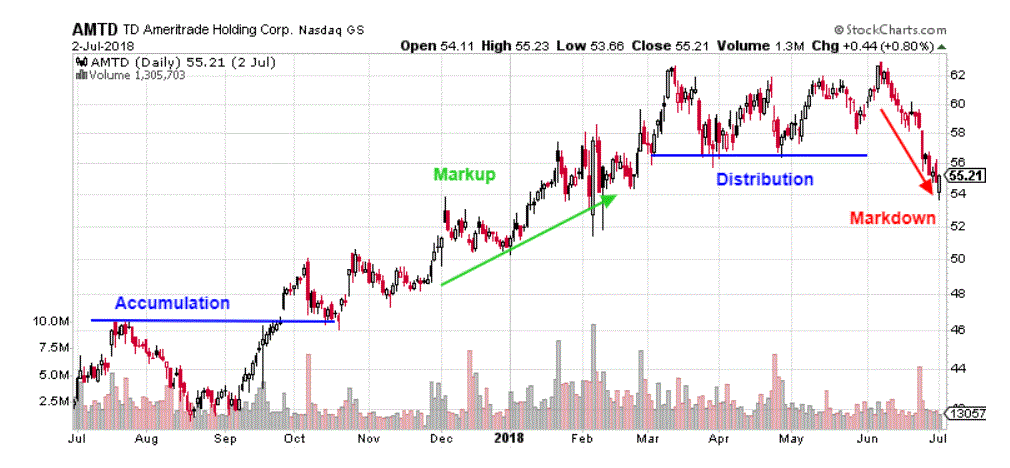What is a Stock Cycle
A stock cycle is the evolution of a stock's price from an early uptrend to price high through to a downtrend and price low. Richard Wyckoff, a prominent trader and pioneer in technical analysis, developed a buy-and-sell stock cycle that occurs over four stages:
1. Accumulation
2. Markup
3. Distribution
4. Markdown
Phases of a Stock Cycle
BREAKING DOWN Stock Cycle
The Wyckoff stock cycle has expansion and contraction periods, much like the economic cycle. It can be used for portfolio management allocation, allowing for increased investment during the accumulation and markup phases and profit-taking during the distribution and markdown phases. Investors measure a stock cycle by comparing the distance between lows to help determine where prices are in the current cycle. (For more, see: The Stock Cycle: What Goes Up Must Come Down.)
Understanding the Wyckoff Stock Cycle
Accumulation: An uptrend starts with the accumulation phase. This is where institutional investors slowly begin acquiring large positions in a stock. Investors use support and resistance levels to find suitable entry points at this stage of the stock cycle. For instance, investors may start accumulating a security when it nears the lower end of a well established trading range.
Markup: A breakout of the accumulation period starts the markup cycle. Trend and momentum investors make the bulk of their gains during this phase, as a stock's price continues higher. In this part of the stock cycle, traders use indicators, such as moving averages and trendlines, to help make investment decisions. For example, an investor may buy a stock if it retraces back to its 20-day moving average.
Distribution: Institutional investors start unwinding their positions at this stage of the stock cycle. Price action begins to move sideways, as the bulls and bears fight for control. A bearish technical divergence between a stock's price and technical indicator often starts to appear in the distribution phase. For example, a stock's price may make a higher high while the relative strength index (RSI) makes a lower high.
Markdown: Volatility often increases during this phase, as investors rush to liquidate their positions. Investors use temporary retracements to the upside as an opportunity to sell their shares, while traders look to open short positions to take advantage of falling prices. Typically, margin calls increase near the conclusion of the markdown cycle, as stock prices near their lows, which may help explain the climactic volume often associated with this part of the stock cycle. (See also: Market Cycles: The Key to Maximum Returns.)

:max_bytes(150000):strip_icc()/active-trading-lrg-4-5bfc2b2546e0fb00517bcd33.jpg)
:max_bytes(150000):strip_icc()/shutterstock_267775109-5bfc35e7c9e77c005145dc96.jpg)
:max_bytes(150000):strip_icc()/google_alphabet_shutterstock_227706004-5c0fc096c9e77c00017f919d.jpg)
:max_bytes(150000):strip_icc()/stocks-lrg-4-5bfc3583c9e77c005878e769.jpg)
:max_bytes(150000):strip_icc()/wall_street_179681980-5bfc2b9746e0fb0083c07d29.jpg)